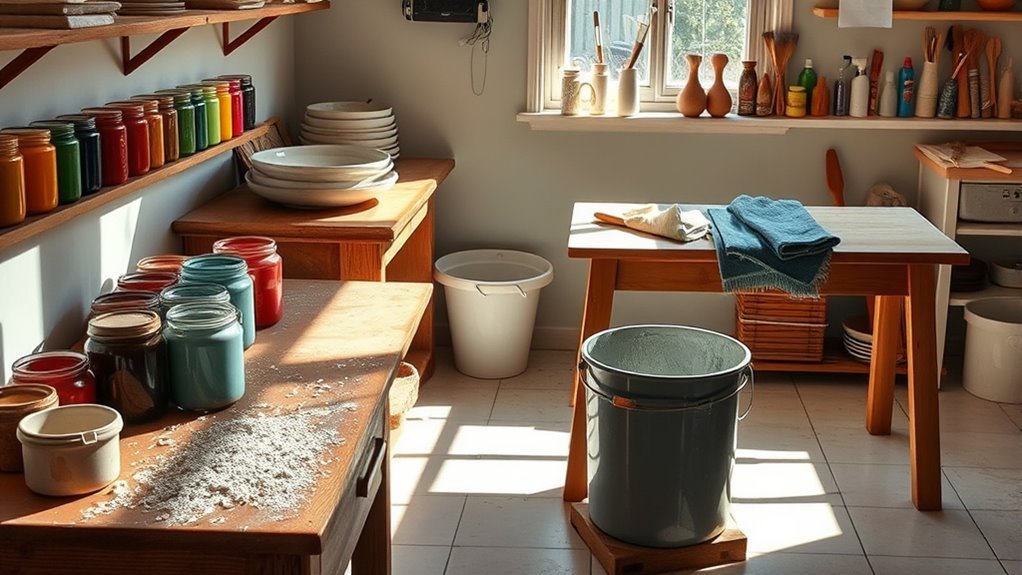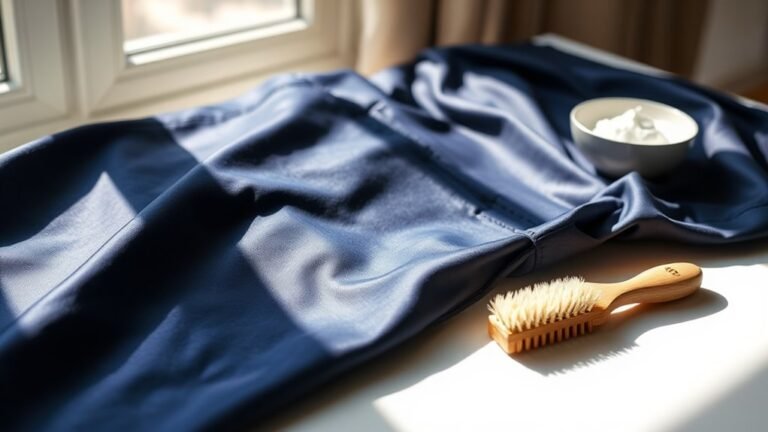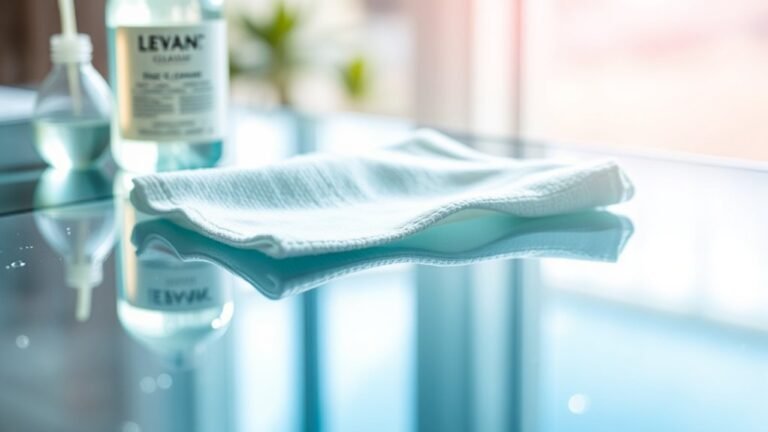How to Clean and Maintain a Home Pottery Studio
To keep your home pottery studio clean and productive, use soft brushes and microfiber cloths for daily wiping, sweep floors regularly, and organize materials in labeled containers. Clean your tools gently with warm water, dry them well, and maintain your wheel and kiln by removing debris and lubricating parts. Control clay dust with damp cloths and improve ventilation to prevent mold. Keeping up with these habits makes your creative space inviting and efficient. Explore deeper tips to master studio maintenance and organization.
Essential Cleaning Supplies for Your Pottery Studio

A well-stocked cleaning kit is key to keeping your pottery studio tidy and safe. You want to choose effective cleaning solutions that tackle clay residue without harsh chemicals, preserving your freedom to create without worry. Essential supplies include soft brushes, sponges, microfiber cloths, and a reliable spray bottle for gentle cleaning solutions. Consider a small vacuum or dustpan for quick clay cleanup. Studio organization is vital—store these supplies in labeled containers or on wall-mounted racks, making everything easy to access when inspiration strikes. Keeping your cleaning kit organized not only saves time but also maintains a clutter-free space, allowing your creativity to flow freely. With the right tools at hand, you’ll enjoy a clean studio that supports your artistic freedom every step of the way.
Daily Cleanup Routine for a Tidy Workspace
Keeping your pottery studio tidy doesn’t have to take long if you stick to a daily cleanup routine. By integrating simple daily habits, you maintain workspace organization effortlessly, freeing your mind for creativity. A quick sweep of your work surface, wiping down tools, and organizing clay scraps prevents buildup and chaos. Here’s a straightforward routine to follow:
| Task | Frequency | Tools Needed |
|---|---|---|
| Sweep floor | Daily | Broom, dustpan |
| Wipe work surfaces | After each use | Damp cloth |
| Organize materials | Daily | Bins, labels |
| Empty trash | Daily | Trash bag |
Sticking to this routine lets you enjoy a clean, inviting studio without sacrificing your creative flow.
Proper Care and Cleaning of Pottery Tools

Once your daily cleanup routine is in place, giving proper attention to your pottery tools becomes much easier. Tool maintenance isn’t just about keeping things spotless—it’s about preserving your creative freedom. After each session, use gentle cleaning techniques like warm water and a soft brush to remove clay residue without damaging blades or wooden handles. Avoid harsh chemicals that can wear down your tools over time. Dry everything thoroughly to prevent rust or mildew, especially metal tools. Store your tools in a well-ventilated space where they won’t get bent or broken. Regularly check for wear and replace parts as needed to keep your tools performing at their best. By maintaining your tools properly, you’re ensuring they’ll be ready whenever inspiration strikes.
Maintaining Your Pottery Wheel and Kiln
You’ll want to keep your pottery wheel clean and well-lubricated to guarantee smooth operation. Regularly wiping down the wheel head and checking for any buildup can prevent damage. For your kiln, removing debris and inspecting elements will help maintain consistent firing results.
Pottery Wheel Care
Regular care of your pottery wheel is essential to keep it spinning smoothly and extend its lifespan. Embracing wheel maintenance guarantees you stay in control, letting creativity flow without interruption. Simple wheel adjustments can make all the difference, freeing you from frustration and allowing your art to take shape effortlessly. Here’s how to maintain your wheel:
- Clean the wheel head and splash pan after each session to prevent buildup.
- Lubricate moving parts regularly to keep the wheel spinning freely.
- Check and tighten bolts and belts to maintain peak performance.
With these steps, your pottery wheel won’t just work—it’ll empower you, granting the freedom to create without limits. Keep it smooth, keep it steady, and watch your passion flourish.
Kiln Cleaning Tips
Just like your pottery wheel, your kiln needs attention to keep it running efficiently and safely. Regular kiln cleaning is essential for kiln safety and kiln maintenance. You’ll want to remove debris inside the chamber and check the element wires for wear. Always clean when the kiln is cool to avoid damage or injury. Maintaining your kiln not only extends its life but also guarantees your creations come out flawless.
| Cleaning Task | Frequency |
|---|---|
| Interior debris removal | After every 10 firings |
| Element inspection | Every 6 months |
| Vent and vent filter | Monthly |
Keep your kiln in top shape, so it reliably frees your creativity without unexpected downtime.
Managing Clay Residue and Dust Control

You’ll want to clean up clay residue regularly to keep your studio safe and tidy. Using wet sponges and mops helps prevent dust from becoming airborne. Let’s look at simple techniques to manage both clay buildup and dust effectively.
Effective Clay Cleanup
Although working with clay can be messy, managing residue and dust effectively is essential to keep your studio safe and functional. You want your creative space to feel liberating, not chaotic. To maintain freedom while ensuring cleanliness, follow these steps:
- Clay disposal: Don’t let scraps pile up. Collect and recycle or dispose of clay properly to avoid buildup.
- Workspace organization: Keep tools and materials in designated spots to minimize dust spread and make cleanup easier.
- Wet cleanup: Use damp cloths or sponges to wipe surfaces, trapping clay particles instead of spreading them into the air.
Dust Prevention Techniques
Since clay dust can pose health risks and damage equipment over time, controlling it is essential in your pottery studio. You’ll want to set up dust barriers around your workspace to keep clay particles from spreading. These can be simple plastic sheets or curtains that contain dust and make cleanup easier. Investing in a quality air filtration system is another smart move; it captures fine dust before it settles, keeping your air cleaner and your lungs happier. When you clean, avoid sweeping—which just kicks dust into the air—instead, use a wet sponge or mop to trap particles. By combining dust barriers with effective air filtration and mindful cleaning habits, you create a safer, freer environment where your creativity can flow without the worry of harmful dust buildup.
Organizing Glazes and Raw Materials Safely
How can you guarantee your glazes and raw materials stay both accessible and safe in your pottery studio? Keeping your creative space free and open means mastering glaze storage and raw material safety to avoid hazards and frustration. Here’s how you can do it:
- Label everything clearly—this saves time and reduces mistakes, giving you freedom to focus on creating.
- Use airtight containers for raw materials to prevent contamination and moisture damage, protecting your supplies and health.
- Designate a specific, ventilated area for storing glazes, so you can find what you need without stress or mess.
Tips for Cleaning and Storing Brushes and Sponges
When you want your brushes and sponges to last, proper cleaning and storage are essential. After each use, rinse brushes thoroughly with warm water to remove clay and glaze residues. Use gentle soap if needed, then reshape bristles and let them dry upright or flat to avoid damage. For brush storage, keep them in a well-ventilated area where air circulates freely, preventing buildup and extending their life. Sponges demand equal care; rinse them until water runs clear to maintain sponge hygiene and prevent hardened clay. Squeeze out excess water and store sponges in a breathable container to keep them fresh. Following these steps lets you enjoy your tools longer, keeping your creative flow uninterrupted and your studio in top shape.
Preventing Mold and Mildew in a Humid Studio
Proper care of your brushes and sponges helps prevent buildup, but in a humid studio, mold and mildew can still become a problem if moisture lingers. To keep your creative space fresh and free, focus on these essential steps:
- Optimize humidity control — Use dehumidifiers or moisture absorbers to keep dampness at bay and protect your tools and surfaces.
- Enhance ventilation systems — Guarantee your studio has good airflow with exhaust fans or open windows to prevent stagnant, mold-friendly air.
- Regularly inspect and dry — Check corners, shelves, and clay storage for damp spots, drying them immediately to stop mold before it starts.
Scheduling Deep Cleaning Sessions for Longevity
Although regular tidying keeps your pottery studio functional, scheduling deep cleaning sessions is essential to maintain its longevity. Set up a cleaning schedule that includes monthly or quarterly deep cleans, depending on how often you use the space. This approach prevents buildup in hard-to-reach areas and protects your tools and equipment. Incorporate these sessions into your maintenance routine, so they become a natural part of your workflow rather than a chore. Deep cleaning not only extends the life of your workspace but also frees you to create without distraction. Remember, a well-maintained studio supports your freedom to experiment and produce art effortlessly. Stick to your cleaning schedule, and your pottery studio will stay fresh and inviting for every creative session.
Frequently Asked Questions
How Often Should I Replace My Pottery Tools?
You should replace your pottery tools based on their tool longevity and how well you’ve kept up with tool maintenance. If you’re regularly cleaning and caring for them, they can last quite a while. But once you notice wear, rust, or damage that affects your work, it’s time to swap them out. Trust your instincts—freedom in your craft means knowing when your tools support your creativity or hold you back.
What Is the Best Way to Dispose of Clay Scraps?
Imagine a mountain of dried clay scraps cluttering your space—that’s not freedom. To keep your studio open and inviting, start with scrap storage: a sealed container where you toss leftover clay. When it’s full, use clay recycling by soaking scraps in water to create slip or reclaim workable clay. This way, you’re not just disposing—you’re transforming waste into fresh potential, freeing your creativity while caring for your environment.
Can I Use Household Cleaners on My Kiln?
You shouldn’t use household cleaners on your kiln because they can damage its components and affect kiln cleaning effectiveness. Instead, stick to products specifically designed for kiln maintenance to guarantee cleaner safety and preserve your equipment’s longevity. Using the wrong cleaner might void warranties or cause hazards, so always check your kiln’s manual or consult the manufacturer. Keeping your kiln in great shape lets you focus on creating without limits.
How Do I Prevent Glaze Contamination Between Projects?
To prevent glaze contamination between projects, you’ll want to keep your glaze storage airtight and clearly labeled. This way, colors and textures won’t mix unintentionally. Also, organizing your tools separately for each glaze helps a ton—dedicate brushes and sponges to specific colors to avoid cross-contamination. Staying organized lets you experiment freely without worrying about ruining your work, so you can keep your creative flow uninterrupted and your pottery vibrant.
What Are Safe Practices for Handling Toxic Glaze Materials?
Before you even open that glaze container, remember this: glaze safety isn’t just a guideline—it’s your freedom’s foundation. You don’t want toxic dust sneaking into your lungs or skin. Always wear protective equipment like gloves, masks, and goggles. Work in a well-ventilated area to keep harmful particles at bay. By respecting these practices, you protect yourself and keep your creative spirit wild and uninhibited, ready to shape your next masterpiece safely.





